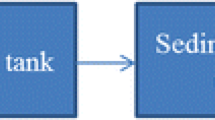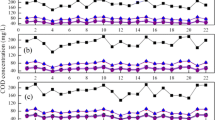Abstract
The feasibility and performance of nitrogen removal from municipal sewage were investigated through the completely autotrophic nitrogen removal over nitrite (CANON) process in a continuous reactor. CANON process was successfully started up with the transformation of nitrogen into gas by mass-balance analysis. For the synthetic wastewater (up to 480 mg NH4 +-N/(L · d)), removal rates of the ammonia nitrogen and total nitrogen (TN) were about 80% and 55%, respectively, at 1.25 h hydraulic retention time (HRT). For the secondary effluent of municipal sewage, the effluent concentrations of NH4 +-N and TN were below 5 mg/L and 9 mg/L, respectively. It is in accordance with the water quality standard for scenic environment with the reuse of urban recycling water (GB/T 18921-2002).
Similar content being viewed by others
References
Yan J, Hu Y Y. Partial nitrification to nitrite for treating ammonium-rich organic wastewater by immobilized biomass system[J]. Bioresource Technology, 2009, 100(8): 2341–2347.
van Dongen U, Jetten M S M, van Loosdrecht M C M. The SHARON-Anammox process for treatment of ammonium rich wastewater [J]. Water Science and Technology, 2001, 44(1): 153–160.
Jetten M S M, Strous M, van de Pas-Schoonen K T et al. The anaerobic oxidation of ammonium [J]. FEMS Microbiology Reviews, 1998, 22(5): 421–437.
Vazquez-Padin J, Mosquera-Corral A, Campos J L et al. Microbial community distribution and activity dynamics of granular biomass in a CANON reactor [J]. Water Research, 2010, 44(15): 4359–4370.
Sliekers A O, Derwort N, Campos-Gomez J L et al. Completely autotrophic nitrogen removal over nitrite in one single reactor [J]. Water Research, 2002, 36(10): 2475–2482.
Kuypers M M M, Sliekers A O, Lavik G et al. Anaerobic ammonium oxidation by Anammox bacteria in the Black Sea [J]. Nature, 2003, 422(6932): 608–611.
Wu Libo, Gong Yue, He Shizhong et al. Star-up of anaerobic ammonium oxidation process in an upflow blanket filter bioreactor [J]. Journal of Tianjin University, 2008, 41(11): 1367–1371(in Chinese).
Wang T, Zhang H M, Yang F L et al. Start-up of the Anammox process from the conventional activated sludge in a membrane bioreactor [J]. Bioresource Technology, 2009, 100(9): 2501–2506.
Strous M, Fuerst J A, Kramer E H M et al. Missing lithotroph identified as new planctomycete [J]. Nature, 1999, 400(6743): 446–449.
National Environmental Protection Agency. Standard Methods for the Examination of Water and Wastewater [M]. China Environmental Science Press, 2005(in Chinese).
Zhang Z J, Chen S H, Wu P et al. Start-up of the Canon process from activated sludge under salt stress in a sequencing batch biofilm reactor (SBBR) [J]. Bioresource Technology, 2010, 101(16): 6309–6314.
Jung J Y, Kang S H, Chung Y C et al. Factors affecting the activity of Anammox bacteria during start up in the continuous culture reactor [J]. Water Science and Technology, 2007, 55(1–2): 459–468.
Bernet N, Sanchez O, Cesbron D et al. Modeling and control of nitrite accumulation in a nitrifying biofilm reactor [J]. Biochemical Engineering Journal, 2005, 24(2): 173–183.
Schmidt I, Sliekers O, Schmid M et al. New concepts of microbial treatment processes for the nitrogen removal in wastewater [J]. FEMS Microbiology Reviews, 2003, 27(4): 481–492.
Isaka K, Date Y, Kimura Y et al. Nitrogen removal performance using anaerobic ammonium oxidation at low temperatures [J]. FEMS Microbiology Letters, 2008, 282(1): 32–38.
Vazquez-Padin J R, Pozo M J, Jarpa M et al. Treatment of anaerobic sludge digester effluents by the CANON process in an air pulsing SBR [J]. Journal of Hazardous Materials, 2009, 166(1): 336–341.
Hao X D, van Loosdrecht M C M. Model-based evaluation of COD influence on a partial nitrification-Anammox biofilm (CANON) process [J]. Water Science and Technology, 2004, 49(11–12): 83–90.
Author information
Authors and Affiliations
Corresponding author
Additional information
Supported by National Natural Science Foundation of China (No. 50308012 and No.21107053); National Science & Technology Program of China (No.2012ZX07501002).
Peng Xinhong, born in 1981, female, doctorate student.
Rights and permissions
About this article
Cite this article
Peng, X., Wu, L., Yu, H. et al. CANON process for nitrogen removal from effluents of municipal sewage treatment plants. Trans. Tianjin Univ. 19, 255–259 (2013). https://doi.org/10.1007/s12209-013-1966-z
Accepted:
Published:
Issue Date:
DOI: https://doi.org/10.1007/s12209-013-1966-z




